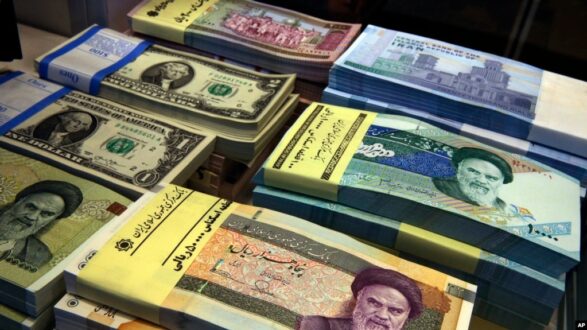iranintl – Reports about a money-losing foreign currency trading scheme at the central bank of Iran has surfaced as the media is abuzz with another large corruption case.
The Central Bank of Iran issued a statement Monday rejecting reports that the bank bought foreign currency at a higher rate and sold it to a cabal of insider businesspeople. The government’s foreign currency policy has been one of the chronic problems in Iran’s economy. The central bank allocates discounted foreign currencies supposedly for essential goods, but they end up at the hands of regime insiders who mainly sell them in the black market for profit.
The parliament’s research center released an analytical report on the recently submitted budget bill of President Ebrahim Raisi’s administration, inadvertently revealing that in the first seven months of the Iranian year (started March 21), the government has spent $4.5 billion more than the foreign currencies obtained from oil revenues, but giving out cheap dollars for the import of five essential goods.
The current exchange rate for the US dollar against Iran’s national currency rial is about 500,000 rials. According to the report, the government has taken $4.5 billion with the rate of Iran’s National Currency and Gold Exchange Center – at about 400,000 rials per dollar — and given to its cherrypicked businessmen at the rate of 285,000 rials per dollar.
According to calculations by Iran’s leading economic daily Donya-e Eqtesad, the difference between these two rates amounts to about 600 trillion rials (about $1.2 billion at current rate at free market) that has been added to the country’s monetary base, further feeding soaring inflation. Essentially the government printed money to buy the dollars at a higher rate and sell it cheaper to importers. The daily predicted that the current trend will lead to an annual rise of about one quadrillion rials ($2 billion), whose inflation will affect the entire society.
“It seems that the insistence of policymakers on promoting welfare policies through currency policies is still in force, with no significant changes in sight. This is happening while currency fluctuations and corruption in the currency allocation process are among the most recognized consequences of welfare-driven currency policies,” Donya-e Eqtesad said. “These policies not only fail to achieve welfare goals but as seen in the tea industry’s foreign currency corruption case, they lead to a multitude of damages to society.”
In fact, ‘welfare’ is just a buzz word, justifying the provision of cheap dollars to people with influence in the political system. Prices for essential goods such as foodstuff continue to rise despite the discounted dollars provided to importers. The justification for cheaper dollars is to keep prices low and prevent higher inflation, but that has not worked as food price inflation stands at around 70 percent.
Iranians are still in shock about recent revelations about a huge corruption case involving nearly $3.5 billion and key Islamic Republic figures. Whenever such cases are revealed, the authorities usually cope out of responsibility by blaming former administrations or officials from the opposing political camp. However, the $3.5 billion embezzlement case of Debsh Tea Company involves officials from both the current and the previous presidential administrations — including ministers of agriculture, industry as well as the governors of the Central Bank of Iran and the chiefs of Iranian Customs Administration. It has also led to discord between the judiciary and the presidential administration as well as the parliament.
 Shabtabnews In this dark night, I have lost my way – Arise from a corner, oh you the star of guidance.
Shabtabnews In this dark night, I have lost my way – Arise from a corner, oh you the star of guidance.



